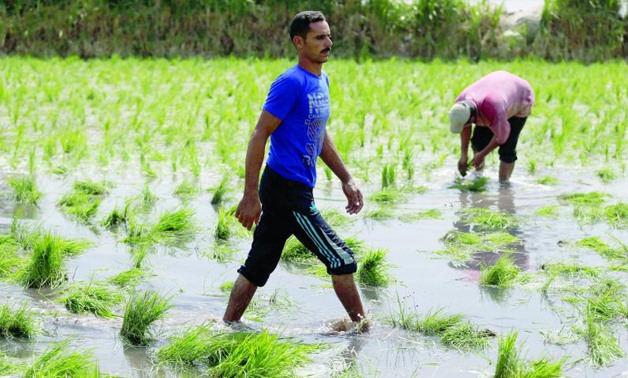
Limited resources. Farmers transplant rice seedlings in a paddy field in Qalyub in Egypt’s El-Kalubia governorate - REUTERS
CAIRO – 21 June 2018: Satellites spotted 576,000 feddans of cultivated rice (one feddan is about 1.038 acres) until now in Egypt’s governorates, said Head of Planning Department and Rain Forecasting Center affiliated with the Irrigation Ministry, Iman Sayed Ahmed.
In a way to mitigate the water scarcity, the Egyptian authorities shrunk the agricultural area allocated for water-intensive crops such as rice.
That the planted area is considered to be within the legally allowed area for rice cultivation per the government's decree, Ahmed added in statements to Egypt Today. However, it’s considered rather constricted compared to the area allocated for rice cultivation last year, which reached 1 million feddans.
According to Sayed's statements, only 50 percent of the legally allowed area for rice cultivation has been used and the rest is expected to be used during the coming period.
In May, Egypt’s government agreed to increase the area allocated for rice cultivation by 100,000 feddans only this season, bringing the total area of rice cultivation to 820,000 feddans.
In April, Egypt's Parliament passed a law banning the cultivation of some crops that require a large amount of water, amid fears that building the Grand Ethiopian Renaissance Dam (GERD) would cut the country's share of the Nile. The Parliament also approved the government's request to amend some provisions in Agriculture Law No. 53 of 1966.
Article 1 in the Agriculture Law refers that the minister of agriculture shall determine the areas to cultivate certain crops, and shall ban other crops in certain areas. Hence, the draft law to amend Article 1 of the Agriculture Law stipulates that the minister of agriculture, in coordination with the minister of irrigation, shall issue a ministerial decree to ban the cultivation of some crops in certain areas that have low amounts of water, in order to rationalize water usage.
Egypt depends entirely on the Nile water for drinking and irrigation purposes, reiterating consistently its "historical right" to the river guaranteed in the 1929 and 1959 Nile agreements, which granted the country 87 percent of the Nile water and the right to veto or approve irrigation projects in the upstream countries.
Egypt annually needs at least 105 billion cubic meters of water to cover the needs of more than 90 million citizens. However, it currently has only 60 billion cubic meters, of which 55.5 billion cubic meters come from the Nile and just less than 5 billion cubic meters coming from non-renewable subterranean water in the desert. The remaining 80 billion cubic meters are covered by the reuse of wastewater.
In 2011, Ethiopia started the construction of the 6,000-megawatt Renaissance Dam over the Blue Nile River, one of the major sources of water that forms the Nile River downstream. Concerns have risen in Cairo and Khartoum over the negative impact the Ethiopian dam will have on their historic Nile water shares.
Since 2014, the three countries (Egypt, Sudan and Ethiopia) have held several tripartite meetings and agreed on the Declaration of Principles. However, the disagreement among the countries is related to the filling and operation period of the dam; Egypt demands that this period be seven to 10 years, while Ethiopia insists on a maximum of three years.


Comments
Leave a Comment